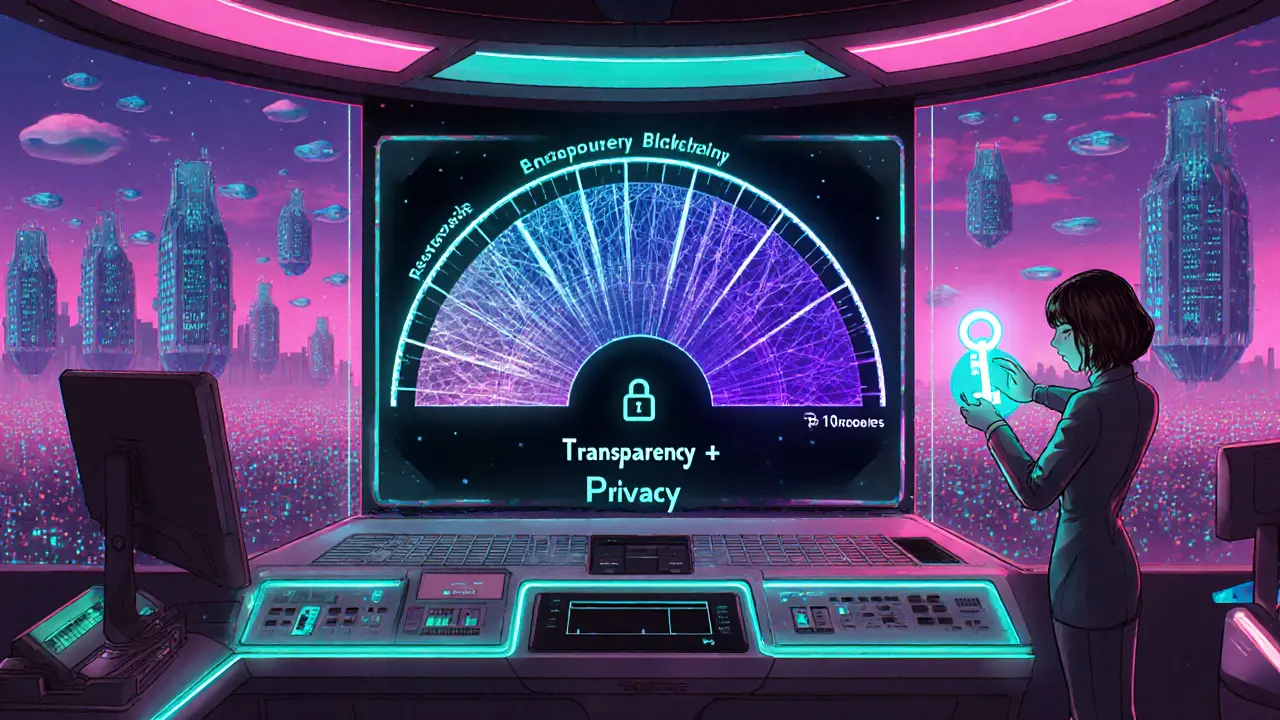Blockchain Transparency vs Privacy: How to Balance Trust and Confidentiality
 Aug, 18 2025
Aug, 18 2025
Blockchain Privacy Solution Selector
Find Your Ideal Privacy Solution
Answer a few questions to identify the best privacy solution for your blockchain project based on your specific needs and constraints.
Enter your preferences to get a recommendation.
When you hear "blockchain", the first thing that pops into mind is usually an open ledger where anyone can see every transaction. That openness builds trust, but it also raises serious privacy questions, especially under regulations like the GDPR. Finding a sweet spot between the two is the biggest challenge for developers, businesses, and regulators today.
Why transparency and privacy feel like opposite ends of a lever
At its core, Blockchain Transparency means that transaction data is stored on a public, immutable ledger that anyone can read and verify. This feature lets users audit supply chains, verify voting results, and prove ownership without a middleman. The downside is that once data lands on the chain, it cannot be erased or hidden.
On the flip side, Blockchain Privacy refers to techniques that hide who did what, how much, or even whether a transaction happened at all. Privacy‑enhancing tools such as zero‑knowledge proofs (ZKPs) or ring signatures let participants keep their identities and amounts confidential while still proving that a transaction follows the rules.
The tension is evident in the European Data Protection Board's 2025 guidelines, which note that "content confidentiality would rely on the mechanisms used (encryption, commitment, etc.)" but also stress the need for immutable integrity. In short, the very thing that makes blockchains trustworthy also threatens personal data rights.
Key regulatory flashpoints
The GDPR’s Article 17 - the right to be forgotten - directly clashes with blockchain immutability. If a user asks a platform to delete personal data, the ledger still holds that information forever. The EDPB’s 2025 guidance suggests using techniques like encryption, where the key itself can be revoked, to achieve a functional equivalent of deletion. However, that approach adds complexity and can hinder auditability.
Other jurisdictions have similar concerns. The United States, with 32 state‑level blockchain statutes, tends to favor innovation over strict privacy, while the EU’s MiCA regulation (effective June 2024) tries to balance transparency requirements with privacy safeguards. The outcome is a patchwork of rules that developers must navigate on a global scale.
Technical toolbox: how to hide data without breaking the chain
Over the past decade, a variety of cryptographic tricks have emerged to reconcile transparency and privacy. Below is a quick rundown of the most impactful solutions.
- Zero‑knowledge proofs (ZKPs): Allow a prover to demonstrate that a statement is true without revealing the underlying data. Zcash, launched in 2016, uses zk‑SNARKs to keep sender, receiver, and amount hidden.
- Ring signatures and stealth addresses: Deployed by Monero since 2014, these obscure transaction links by mixing multiple inputs together, making deanonymization much harder.
- Secure multi‑party computation (sMPC): Enables parties to jointly compute a function over private inputs without exposing them. Zama’s 2023 FHE implementation pushes this further by allowing arbitrary computation on encrypted data.
- Homomorphic encryption: Processes encrypted data directly. Though still heavy - roughly 1,000× the CPU load of plain operations - recent advances cut the overhead to about 150×, opening doors for private smart contracts.
- Layer‑2 off‑chain solutions: State channels (e.g., Raiden Network for Ethereum) and sidechains (e.g., Liquid for Bitcoin) move sensitive interactions off the main ledger, preserving privacy while retaining security guarantees.
- Permissioned blockchains: Platforms like Hyperledger Fabric and R3 Corda restrict access to vetted participants, offering confidentiality at the cost of reduced decentralization.
- Selectively disclosed data: The Midnight Foundation’s protocol update (2024) lets users flag which fields stay private and which are visible, achieving a 87% privacy rate on transactions while staying compliant.
Each method carries trade‑offs in speed, cost, and auditability. For instance, ZKPs increase transaction size by 300‑500% and processing time by up to 300%, while off‑chain channels can handle over a million transactions per second but expose users to a different set of security risks.

Comparative snapshot: transparency‑focused vs privacy‑focused approaches
| Solution | Transparency Level | Privacy Strength | Scalability (TPS) | Decentralization |
|---|---|---|---|---|
| Public Blockchain (e.g., Bitcoin) | 100 % | Low - pseudonymity only | ~30 | Very High (15,000+ nodes) |
| Private Blockchain (e.g., Hyperledger Fabric) | Low - permissioned view | High - access control | ~2,000 | Medium (15‑20 nodes) |
| Zero‑knowledge Proofs (Zcash) | Medium - shielded vs transparent pool | Very High - full data concealment | ~15 (due to larger tx size) | High |
| Layer‑2 State Channels (Raiden) | Low - off‑chain | High - private settlement | >1,000,000 | High (inherits mainnet security) |
| Selective Disclosure (Midnight Foundation) | Variable - user‑defined | High - encrypted fields | ~200 | High |
These numbers illustrate why no single solution fits every use case. Companies must weigh what matters more: auditability, speed, or confidentiality.
Industry case studies - where the balance matters most
Financial services use blockchain for cross‑border payments, but adding privacy layers bumps KYC/AML compliance costs by 30‑45 % (SWIFT 2024). Banks that adopted ZK‑enabled protocols report lower exposure to data‑leak lawsuits, yet they face longer settlement times.
Healthcare pilots storing patient records on a blockchain struggle with HIPAA and GDPR compatibility. A 2024 survey found 68 % of projects failed because data could not be sufficiently anonymized without breaking audit trails.
Supply chain players like IBM Food Trust appreciate the visibility of provenance, but confidential supplier contracts clash with the public nature of the ledger. Onboarding times stretch by 25‑35 % when companies must negotiate data‑visibility clauses.
These examples show that the cost of privacy isn’t just technical - it’s also operational and regulatory.

Best‑practice checklist for balancing the two
- Start with a privacy‑by‑design mindset. Map data flows early and decide which fields need encryption or selective disclosure.
- Pick the right ledger type: public for maximum trust, permissioned for confidential enterprise use, or a hybrid model that uses sidechains for sensitive data.
- Leverage proven cryptography: ZKPs for strong anonymity, ring signatures for moderate privacy, and sMPC for collaborative computations. \n
- Implement key‑revocation strategies. Store personal data off‑chain encrypted; destroy the key when a deletion request arrives.
- Run regular compliance drills. Simulate GDPR erasure requests and verify that audit logs remain intact.
- Monitor emerging standards. The World Economic Forum’s 2025 "privacy‑preserving transparency" framework offers a roadmap for regulators and developers.
Following this checklist helps you avoid the common pitfall of bolting privacy on after launch - a mistake that Dr. Ann Cavoukian warns can render a system insecure by design.
Future outlook - will privacy become native to blockchains?
Survey data from ConsenSys (Q1‑2025) shows 78 % of developers rank privacy as their top priority. Meanwhile, Zama’s latest FHE prototype cuts processing overhead to a manageable 150×, making private smart contracts more feasible. The Midnight Foundation’s selective‑disclosure upgrade already powers 22 % of enterprise deployments, up from 8 % in 2022.
All signs point to a convergence: next‑generation protocols will embed privacy primitives at the protocol layer, rather than treating them as add‑ons. When that happens, the old binary of "transparent vs private" will dissolve into a spectrum where each transaction can be tuned for the exact level of visibility the regulator and the business demand.
Quick takeaways
- Transparency builds trust, but can clash with GDPR’s right to be forgotten.
- ZKPs, ring signatures, and sMPC are the leading cryptographic tools for privacy.
- Public blockchains are fully transparent; permissioned blockchains trade decentralization for confidentiality.
- Off‑chain solutions boost scalability but introduce new security risks.
- Adopting a privacy‑by‑design approach early saves compliance costs and avoids retrofitting headaches.
Can a public blockchain ever fully comply with GDPR?
Strict compliance is challenging because GDPR’s erasure right conflicts with immutability. However, using encryption with revocable keys or storing personal data off‑chain while keeping hashes on‑chain can provide a practical workaround.
What’s the performance impact of zero‑knowledge proofs?
ZKPs typically increase transaction size by 300‑500 % and verification time by 200‑300 % compared to transparent transactions. Newer zk‑STARKs and recursive proof techniques are narrowing that gap.
Are private blockchains less secure than public ones?
Security depends on the consensus model and node diversity. Permissioned networks have fewer nodes (15‑20 on average) but can enforce strict identity checks, reducing certain attack vectors while increasing reliance on trusted parties.
How do layer‑2 state channels protect privacy?
Transactions stay off the main chain until the channel is settled, keeping details hidden from public observers. Only the final balance proof is posted, which reveals no intermediate steps.
What future standards should I watch for?
The World Economic Forum’s 2025 privacy‑preserving transparency framework and the EU’s upcoming updates to the EDPB guidelines are key. Both aim to harmonize cryptographic privacy methods with regulatory requirements.
Melodye Drake
October 24, 2025 AT 00:14Look, I get that people love to throw around "privacy by design" like it's some sacred mantra, but let's be real-most of these ZKP implementations are just expensive theater. You're trading 300% slower transactions for the illusion of secrecy while still storing hashes on-chain. GDPR doesn't care about your fancy cryptography if the metadata leaks. And don't even get me started on how "selective disclosure" is just a fancy word for "I'll show you what I want you to see."
Real privacy isn't about hiding data-it's about not collecting it in the first place. But no, we'd rather build Rube Goldberg machines to justify our blockchain fetish.
paul boland
October 24, 2025 AT 22:55AND YOU CALL IT "ILLUSION"?? BRO, I’M IRISH-WE’VE BEEN HIDING STUFF SINCE THE FAMINE. ZKPS ARE JUST MODERN DAY CLOAKS. 🤫⚔️
IF YOU HATE BLOCKCHAIN SO MUCH, WHY ARE YOU EVEN HERE?? GO BACK TO YOUR EXCEL SPREADSHEETS AND CRY IN YOUR CUBICLE 📊😭
harrison houghton
October 25, 2025 AT 15:15There is a deeper truth here. Not just about code. Not just about regulation. But about human nature.
We crave transparency because we fear being lied to. We demand privacy because we fear being seen. These are not technical problems. They are existential ones.
Blockchain, in its purest form, is a mirror. It reflects our obsession with control. With proof. With permanence. But we are not machines. We are fragile, flawed, and haunted by memory.
When the GDPR says "right to be forgotten," it is not about data. It is about redemption. It is about the chance to become someone else.
Can a ledger forgive? Can a hash uncompute? Can a chain unchain itself?
Maybe not. But maybe that’s not the point.
The point is: we are trying. We are reaching. We are building something that doesn’t yet exist-not for efficiency. Not for compliance. But because we are afraid of being erased without being heard.
DINESH YADAV
October 25, 2025 AT 17:50rachel terry
October 26, 2025 AT 05:40Just use a sidechain and call it a day
Why are we even arguing about this like it’s a philosophy exam
It’s just code
And if someone wants to delete their data
They should’ve thought about that before they signed up
Also zero knowledge proofs are so 2021
Susan Bari
October 26, 2025 AT 12:29We’re not solving privacy
We’re just designing better cages
Every new protocol is another lock on the door
But the prisoner is still inside
And the jailer is still watching
They call it "selective disclosure" but it’s just permissioned visibility
They call it "privacy by design" but it’s just compliance theater
The blockchain was supposed to set us free
Instead we made it a notary for our anxieties
Marlie Ledesma
October 27, 2025 AT 08:57